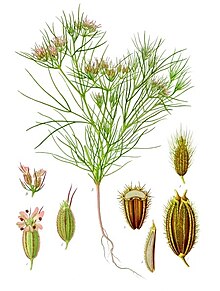| Cumin | |
|---|---|

| |
| Scientific classification | |
| Kingdom: | Plantae |
| Clade: | Tracheophytes |
| Clade: | Angiosperms |
| Clade: | Eudicots |
| Clade: | Asterids |
| Order: | Apiales |
| Family: | Apiaceae |
| Genus: | Cuminum |
| Species: | C. cyminum
|
| Binomial name | |
| Cuminum cyminum | |
Cumin (/ˈkʌmɪn/,[2][3] /ˈkjuːmɪn/;[2][3] US also /ˈkuːmɪn/;[2] Cuminum cyminum) is a flowering plant in the family Apiaceae, native to the Irano-Turanian Region.[4] Its seeds – each one contained within a fruit, which is dried – are used in the cuisines of many cultures in both whole and ground form. Although cumin is used in traditional medicine, there is no high-quality evidence that it is safe or effective as a therapeutic agent.[5]
- ^ "Cuminum cyminum". Germplasm Resources Information Network. Agricultural Research Service, United States Department of Agriculture. Retrieved 13 March 2008.
- ^ a b c "Cumin". Merriam-Webster: Dictionary. 8 February 2024. Retrieved 20 February 2024.
- ^ a b "Cumin". Oxford Learner's Dictionaries. Retrieved 20 February 2024.
- ^ Kislev, Mordechai E.; Hartmann, Anat; Galili, Ehud (1 September 2004). "Archaeobotanical and archaeoentomological evidence from a well at Atlit-Yam indicates colder, more humid climate on the Israeli coast during the PPNC period". Journal of Archaeological Science. 31 (9): 1301–1310. Bibcode:2004JArSc..31.1301K. doi:10.1016/j.jas.2004.02.010. ISSN 0305-4403.
- ^ "Cumin". Drugs.com. 2018. Retrieved 24 February 2018.